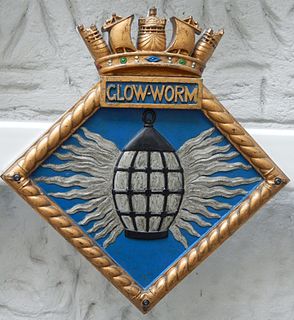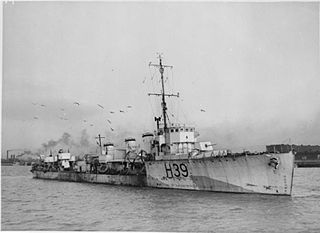Related Research Articles
Eight ships of the Royal Navy have been named HMS Ardent, whilst another two were planned:
Thirteen ships of the British Royal Navy have been named HMS Surprise or HMS Surprize, including:

The V and W class was an amalgam of six similar classes of destroyer built for the Royal Navy under the 9th, 10th, 13th and 14th of fourteen War Emergency Programmes during the First World War and generally treated as one class. For their time they were among the most powerful and advanced ships of their type in the world, and set the trend for future British designs.
Three ships of the Royal Navy have been named HMS Quorn, all named after the Quorn Hunt.

Three ships of the Royal Navy have borne the name HMS Glowworm after the insect, whilst two more were planned:
Four Royal Navy ships have been named HMS Grenville. Vice Admiral Sir Richard Grenville was an Elizabethan sailor, explorer, and soldier:
Seven ships of the Royal Navy have been named HMS Hecla, after the volcano Hekla in Iceland.
Seven ships of the Royal Navy have been named HMS Orpheus. Orpheus was the magical father of songs in Greek mythology.
Nine ships of the Royal Navy have borne the name HMS Diana after the figure from Roman mythology, whilst another was planned but later cancelled:

The Yarrow M class was a class of ten destroyers built for the Royal Navy that saw service during World War I. They were generally similar to the standard Admiralty M-class destroyer, but were instead designed by the builder, Yarrow & Company. Generally, they had two instead of three shafts, as well as two funnels and a straight stern, with the bridge set well back from the forecastle. The first trio were two knots faster than the Admiralty M type, despite less installed power and one less shaft; the installed power was increased for the later vessels. Jane's Fighting Ships describes the class as "very successful boats", and all ten vessels survived throughout the war to be broken up during the 1920s. Moon, Mounsey and Musketeer were each fitted to carry a kite balloon.

The first R class were a class of 62 destroyers built between 1916 and 1917 for the Royal Navy. They were an improvement, specifically in the area of fuel economy, of the earlier Admiralty M-class destroyers. The most important difference was that the Admiralty R class had two shafts and geared turbines, compared with the three shafts and direct turbines of the Admiralty M class, but in appearance the R class could be distinguished from its predecessors by having the after 4-inch gun mounted in a bandstand. The Admiralty ordered the first two of this class of ships in May 1915. Another seventeen were ordered in July 1915, a further eight in December 1915, and a final twenty-three in March 1916.

The S class was a class of 67 destroyers ordered for the Royal Navy in 1917 under the 11th and 12th Emergency War Programmes. They saw active service in the last months of the First World War and in the Russian and Irish Civil Wars during the early 1920s. Most were relegated to the reserve by the mid-1920s and subsequently scrapped under the terms of the London Naval Treaty. Eleven survivors saw much action during the Second World War.
Two ships of the Royal Navy have been named HMS Wren after the bird.
Four vessels of the Royal Navy have been named HMS Ribble, after the English river:
Five ships of the Royal Navy have borne the name HMS Duchess:
Two ships of the Royal Navy have been called HMS Sable after the small carnivorous mammal:
Four ships of the Royal Navy have borne the name HMS Sabrina. Another was planned but never completed:
Six vessels of the Royal Navy have been named HMS Ready:
Two ships of the Royal Navy have borne the name HMS Relentless:
References
- Colledge, J. J.; Warlow, Ben (2006) [1969]. Ships of the Royal Navy: The Complete Record of all Fighting Ships of the Royal Navy (Rev. ed.). London: Chatham Publishing. ISBN 978-1-86176-281-8.